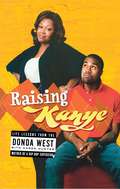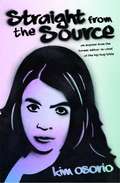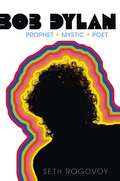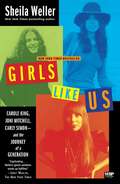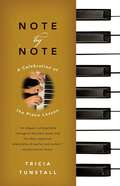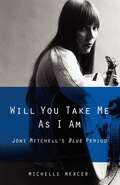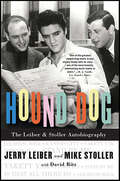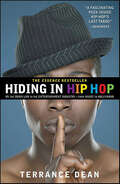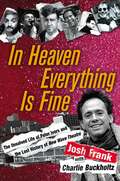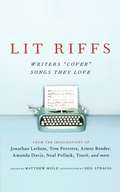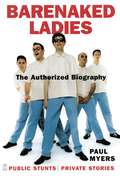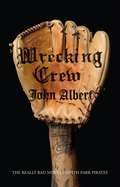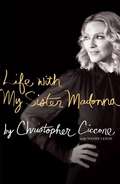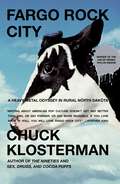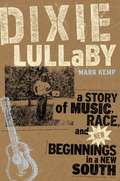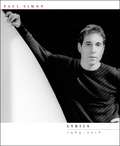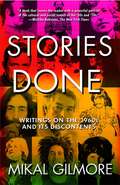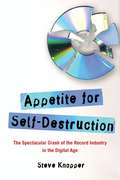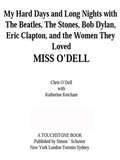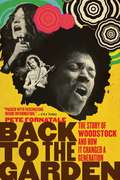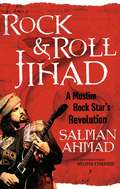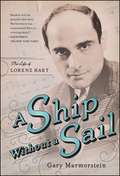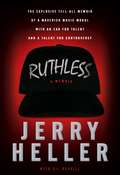- Table View
- List View
Raising Kanye: Life Lessons from the Mother of a Hip-hop Superstar
by Karen Hunter Donda West Kanye WestAs the mother of hip-hop superstar Kanye West, Donda West has watched her son grow from a brilliant baby boy with all the intimations of fame and fortune to one of the hottest rappers on the music scene. And she has every right to be proud: she raised her son with strong moral values, teaching him right from wrong and helping him become the man he is today. In Raising Kanye, Donda not only pays homage to her famous son but reflects on all the things she learned about being his mother along the way. Featuring never-before-seen photos and compelling personal anecdotes, Donda's powerful and inspiring memoir reveals everything from the difficulties she faced as a single mother in the African-American community to her later experiences as Kanye's manager as he rose to superstardom. Speaking frankly about her son's reputation as a "Mama's Boy," and his memorable public outbursts about gay rights and President George W. Bush, Donda supports her son without exception, and here she shares the invaluable wisdom she has taken away from each experience -- passion, tolerance, patience, and above all, always telling the truth. Ultimately, she not only expresses what her famously talented son has meant to her but what he has meant to music and an entire generation.
Straight from the Source
by Kim OsorioKim Osorio had a front-row seat for the biggest beefs, battles, and blow-ups in hip-hop. As the first female editor-in-chief of The Source, she had come up. From her corner office, Kim got the goods on hip-hop's hottest names: Jay-Z, Nas, 50 Cent, Lil' Kim. She developed close -- sometimes intimate -- relationships with the artists she exposed to the public. But The Source couldn't hide its own dirty laundry for long. Behind the scenes, the magazine's volatile owners puppeteered every issue -- even coveted honors like the 5-mic album rating and the Power 30 list of industry heavy-hitters. Then The Source declared war on Eminem and began the notorious assault that would send the magazine into swift decline. In a culture dominated by men, Kim rose to the top, and after years in the magazine's pressure cooker, she hit "send" on a two-sentence e-mail that would thrust her from the sidelines of the scandalous world she reported on to the center of one of the most explosive scandals in hip-hop history. Straight From the Source is the Book of Kim, the tell-all memoir only she could write about her influential years at the Bible of Hip-Hop.
Bob Dylan: Prophet, Mystic, Poet
by Seth RogovoyBob Dylan and his artistic accomplishments have been explored, examined, and dissected year in and year out for decades, and through almost every lens. Yet rarely has anyone delved extensively into Dylan's Jewish heritage and the influence of Judaism in his work. In Bob Dylan: Prophet, Mystic, Poet, Seth Rogovoy, an award-winning critic and expert on Jewish music, rectifies that oversight, presenting a fascinating new look at one of the most celebrated musicians of all time. Rogovoy unearths the various strands of Judaism that appear throughout Bob Dylan's songs, revealing the ways in which Dylan walks in the footsteps of the Jewish Prophets. Rogovoy explains the profound depth of Jewish content -- drawn from the Bible, the Talmud, and the Kabbalah -- at the heart of Dylan's music, and demonstrates how his songs can only be fully appreciated in light of Dylan's relationship to Judaism and the Jewish themes that inform them. From his childhood growing up the son of Abe and Beatty Zimmerman, who were at the center of the small Jewish community in his hometown of Hibbing, Minnesota, to his frequent visits to Israel and involvement with the Orthodox Jewish outreach movement Chabad, Judaism has permeated Dylan's everyday life and work. Early songs like "Blowin' in the Wind" derive central imagery from passages in the books of Ezekiel and Isaiah; mid-career numbers like "Forever Young" are infused with themes from the Bible, Jewish liturgy, and Kabbalah; while late-period efforts have revealed a mind shaped by Jewish concepts of Creation and redemption. In this context, even Dylan's so-called born-again period is seen as a logical, almost inevitable development in his growth as a man and artist wrestling with the burden and inheritance of the Jewish prophetic tradition. Bob Dylan: Prophet, Mystic, Poet is a fresh and illuminating look at one of America's most renowned -- and one of its most enigmatic -- talents.
Girls Like Us: Carole King, Joni Mitchell, Carly Simon--And the Journey of a Generation
by Sheila WellerA groundbreaking and irresistible biography of three of America's most important musical artists -- Carole King, Joni Mitchell, and Carly Simon -- charts their lives as women at a magical moment in time. Carole King, Joni Mitchell, and Carly Simon remain among the most enduring and important women in popular music. Each woman is distinct. Carole King is the product of outer-borough, middle-class New York City; Joni Mitchell is a granddaughter of Canadian farmers; and Carly Simon is a child of the Manhattan intellectual upper crust. They collectively represent, in their lives and their songs, a great swath of American girls who came of age in the late 1960s. Their stories trace the arc of the now mythic sixties generation -- female version -- but in a bracingly specific and deeply recalled way, far from cliché. The history of the women of that generation has never been written -- until now, through their resonant lives and emblematic songs. Filled with the voices of many dozens of these women's intimates, who are speaking in these pages for the first time, this alternating biography reads like a novel -- except it's all true, and the heroines are famous and beloved. Sheila Weller captures the character of each woman and gives a balanced portrayal enriched by a wealth of new information. Girls Like Us is an epic treatment of midcentury women who dared to break tradition and become what none had been before them -- confessors in song, rock superstars, and adventurers of heart and soul.
Note by Note: A Celebration of the Piano Lesson
by Tricia TunstallIn this luminous book, Tricia Tunstall explores the enduring fascination of the piano lesson. Even as everything else about the world of music changes, the piano lesson retains its appeal. Drawing on her own lifelong experience as a student and teacher, Tunstall writes about the mysteries and delights of piano teaching and learning. What is it that happens in a piano lesson to make it such a durable ritual? In a world where music is heard more often on the telephone and in the elevator than in the concert hall, why does the piano lesson still have meaning in the lives of children? What does it matter whether one more child learns to play Bach's Minuet in G? Note by Note is in part a memoir in which Tunstall recalls her own childhood piano teachers and their influence. As she observes, the piano lesson is unlike the experience of being coached on an athletic team or taught in a classroom, in that it is a one-on-one, personal communication. Physically proximate, mutually concentrating on the transfer of a skill that is often arduous, complicated and frustrating, teacher and student occasionally experience breakthroughs-moments of joy when the student has learned something, mastered a musical passage or expressed a feeling through music. The relationship is not only one-way: teaching the piano is a lifelong endeavor of particular intensity and power. Anyone who has ever studied the piano-or wanted to-will cherish this gem of a book.
Will You Take Me As I Am
by Michelle MercerJoni Mitchell is one of the most celebrated artists of the last half century, and her landmark 1971 album, Blue, is one of her most beloved and revered works. Generations of people have come of age listening to the album, inspired by the way it clarified their own difficult emotions. Critics and musicians admire the idiosyncratic virtuosity of its compositions. Will You Take Me As I Am -- the first book about Joni Mitchell to include original interviews with her -- looks at Blue to explore the development of an extraordinary artist, the history of songwriting, and much more. In extensive conversations with Mitchell, Michelle Mercer heard firsthand about Joni's internal and external journeys as she composed the largely autobiographical albums of what Mercer calls her Blue Period, which lasted through the mid-1970s. Incorporating biography, memoir, reportage, criticism, and interviews into an illuminating narrative, Mercer moves beyond the "making of an album" genre to arrive at a new form of music writing. In 1970, Mitchell was living with Graham Nash in Laurel Canyon and had made a name for herself as a so-called folk singer notable for her soaring voice and skillful compositions. Soon, though, feeling hemmed in, she fled to the hippie cave community of Matala, Greece. Here and on further travels, her compositions were freshly inspired by the lands and people she encountered as well as by her own radically changing interior landscape. After returning home to record Blue, Mitchell retreated to British Columbia, eventually reemerging as the leader of a successful jazz-rock group and turning outward in her songwriting toward social commentary. Finally, a stint with Bob Dylan's Rolling Thunder Revue and a pivotal meeting with the Tibetan lama ChÖgyam Trungpa prompted Mitchell's return to personal songwriting, which resulted in her 1976 masterpiece album, Hejira. Mercer interlaces this fascinating account of Mitchell's Blue Period with meditations on topics related to her work, including the impact of landscape on music, the value of autobiographical songwriting for artist and listener, and the literary history of confessionalism. Mercer also provides rich analyses of Mitchell's creative achievements: her innovative manner of marrying lyrics to melody; her inventive, highly expressive chords that achieve her signature blend of wonder and melancholy; how she pioneered personal songwriting and, along with Bob Dylan and Leonard Cohen, brought a new literacy to the popular song. Fans will appreciate the previously unpublished photos and a coda of Mitchell's unedited commentary on the places, books, music, pastimes, and philosophies she holds dear. This utterly original book offers a unique portrait of a great musician and her remarkable work, as well as new perspectives on the art of songwriting itself.
Hound Dog: The Leiber & Stoller Autobiography
by Jerry Leiber Mike Stoller David RitzThe hitmakers behind Elvis Presley&’s &“Hound Dog&” and &“Jailhouse Rock&” recount their rise to songwriting stardom while authoring the classic American R&B sound of countless chart-topping singles.In 1950 a couple of rhythm and blues–loving teenagers named Jerry Leiber and Mike Stoller met for the first time. They discovered their mutual affection for R&B and, as Jerry and Mike put it in this fascinating autobiography, began an argument that has been going on for over fifty years with no resolution in sight.Leiber and Stoller were still in their teens when they started working with some of the pioneers of rock and roll, writing such hits as "Hound Dog," which eventually became a #1 record for Elvis Presley. Jerry and Mike became the King&’s favorite songwriters, giving him "Jailhouse Rock" and other #1 songs. Their string of hits with the Coasters, including "Yakety Yak," "Poison Ivy," and "Charlie Brown," is a part of rock &’n&’ roll history. They founded their own music label and introduced novel instrumentation into their hits for the Drifters and Ben E. King, including "On Broadway" and "Stand by Me." They worked with everyone from Phil Spector to Burt Bacharach and Peggy Lee. Their smash musical Smokey Joe&’s Café became the longest-running musical revue in Broadway history.Lively, colorful, and irreverent, Hound Dog describes how two youngsters with an insatiable love of good old American R&B created the soundtrack for a generation.
Hiding in Hip Hop: On the Down Low in the Entertainment Industry—from Music to Hollywood
by Terrance Dean&“If you&’re a fan of the hit show Empire and its characters Cookie, Lucious, Hakeem, Jamal, and Andre, then you have to check out Terrance Dean&’s provocative memoir Hiding in Hip Hop. Dean writes a compelling story about black gay men in Hip Hop and Hollywood, and what it takes for them to make it the entertainment industry.&” – JL King, New York Times bestselling author of On The Down LowCelebrated blogger and former MTV insider Terrance Dean reveals a hidden side of Hollywood and hip hop in this explosive and illuminating memoir.Terrance Dean worked his way up for more than ten years in the entertainment industry from intern to executive and has lived the life of glitz and bling along with Hollywood and Hip Hop&’s most glamorous heavy hitters. As a gay man immersed within the world of the famous and the fabulous, Dean knows well the industry&’s secrets and the façade that is kept, that for men, promotes machismo and heteronormative behavior.Most of what Dean unveils in this book is fascinating and salacious, but all of it is true. He also shares his own secrets, and an account of the pain of his mother&’s addiction, and the poverty and molestation he experienced as a child.Hiding in Hip Hop is not a traditional tell-all. It&’s personal. It&’s poignant. It&’s a provocative and honest look at stardom and sexuality.
In Heaven Everything Is Fine: The Unsolved Life of Peter Ivers and the Lost History of New Wave Theatre
by Josh Frank Charlie BuckholtzOn March 3, 1983, Peter Ivers was found bludgeoned to death in his loft in downtown Los Angeles, ending a short-lived but essential pop cultural moment that has been all but lost to history. For the two years leading up to his murder, Ivers had hosted the underground but increasingly popular LA-based music and sketch-comedy cable show New Wave Theatre. The late '70s through early '80s was an explosive time for pop culture:Saturday Night Live and National Lampoon were leading a comedy renaissance, while punk rock and new wave were turning the music world on its head. New Wave Theatre brought together for the first time comedians-turned-Hollywood players like John Belushi, Chevy Chase, and Harold Ramis with West Coast punk rockers Black Flag, the Dead Kennedys, Fear, and others, thus transforming music and comedy forever. The show was a jubilant, chaotic punk-experimental-comedy cabaret, and Ivers was its charismatic leader and muse. He was, in fact, the only person with the vision, the generosity of spirit, and the myriad of talented friends to bring together these two very different but equally influential worlds, and with his death the improbable and electric union of punk and comedy came to an end. The magnetic, impishly brilliant Ivers was a respected musician and composer (in addition to several albums, he wrote the music for the centerpiece song of David Lynch's cult classic Eraserhead) whose sublime and bizarre creativity was evident in everything he did. He was surrounded by people who loved him, many of them luminaries: his best friend from his Harvard days was Doug Kenney, founder ofNational Lampoon; he was also close to Harold Ramis and John Belushi. Upon his death, Ivers was just beginning to get mainstream recognition. In Heaven Everything Is Fine is the first book to explore both the fertile, gritty scene that began and ended with New Wave Theatre and the life and death of its guiding spirit. Josh Frank, author of Fool the World: The Oral History of a Band Called Pixies, interviewed hundreds of people from Ivers's circle, including Jello Biafra, Stockard Channing, and David Lynch, and we hear in their own words about Ivers and the marvelous world he inhabited. He also spoke with the Los Angeles Police Department about Ivers's still-unsolved murder, and, as a result of his research, the Cold Case Unit has reopened the investigation. In Heaven Everything Is Fine is a riveting account of a gifted artist, his tragic death, and a little-known yet crucial chapter in American pop history.
Lit Riffs
by Tom Perrotta Neal Pollack Heidi Julavitz Matthew Miele Lester Bangs Aimee Bender Jonathan Lethem Amanda Davis J. T. LeRoy TouréFollowing in the footsteps of the late great Lester Bangs -- the most revered and irreverent of rock 'n' roll critics -- twenty-four celebrated writers have penned stories inspired by great songs. Just as Bangs cast new light on a Rod Stewart classic with his story "Maggie May," about a wholly unexpected connection between an impressionable young man and an aging, alcoholic hooker, the diverse, electrifying stories here use songs as a springboard for a form dubbed the lit riff. Alongside Bangs's classic work, you'll find stories by J.T. LeRoy, who puts a recovering teenage drug abuser in a dentist's chair with nothing but the Foo Fighters's "Everlong" -- blaring through the P.A. -- to fight the pain; Jonathan Lethem, whose narrator looks back on his lost innocence just as an extramarital affair careens to an end -- this to the tune "Speeding Motorcycle" as recorded by Yo La Tengo; and Jennifer Belle, who envisions a prequel to Paul Simon's "Graceland" -- one that takes place at a children's birthday party replete with a real live kangaroo. With original contributions from Tom Perrotta, Nelson George, Amanda Davis, Lisa Tucker, Aimee Bender, Darin Strauss, and many more -- riffing on everyone from Tom Waits and Bruce Springsteen to the White Stripes, Cat Power, and Bob Marley -- this is both an astounding collection of short stories and an extraordinary experiment in words and music. Soundtrack available from Saturation Acres Music & Recording Co.
Barenaked Ladies: Public Stunts, Private Stories
by Paul MyersWant to know more about this Canadian quintet? It's all here, from the births of five Barenaked babies to the triumph of band member Kevin over leukemia.
Wrecking Crew: The Really Bad News Griffith Park Pirates
by John Albert"You never know what's going to save you. "After years of dingy nightclubs and drug addiction, John Albert and his hard-luck friends certainly never expected their salvation to arrive in the form of a pastime most often associated with Mom, God, and apple pie. Wrecking Crew -- a highly unusual chronicle of recovery and redemption -- documents the transformation of a group of musicians, struggling screenwriters, and wannabe actors into a competitive band of hardballers. For over a decade, it seemed to be enough: the narcotics, gambling, whores, and aimless rebellion. But as they stumbled into their thirties, the blithe pursuit of self-destruction had simply become exhausting to these battle-scarred denizens of the L. A. counterculture. The romantic squalor of being perpetually broken-down, periodically drug-addled, and irresponsible began to lose its charm. The idea of fielding a baseball team to compete in a hard-knocks amateur league seemed merely the latest in a string of half-hearted stabs at restoring order to their ragged lives. But this escapade was different. When these men donned their team uniforms, the old obsessions started to fade and something incredible began to happen. This is the unforgettable story of the Griffith Park Pirates.
Life with My Sister Madonna
by Christopher CicconeChristopher Ciccone's extraordinary memoir is based on his forty-seven years of growing up with, working with, and understanding the most famous woman of our time, who has intrigued, scandalized, and entertained millions for 50 years.
Fargo Rock City: A Heavy Metal Odyssey in Rural North Dakota (Chuck Klosterman On Rock Ser.)
by Chuck KlostermanEmpirically proving that—no matter where you are—kids wanna rock, this is Chuck Klosterman's hilrious memoir of growing up as a shameless metalhead in Wyndmere, North Dakotoa (population: 498).With a voice like Ace Frehley's guitar, Klosterman hacks his way through hair-band history, beginning with that fateful day in 1983 when his older brother brought home Mötley Crüe's Shout at the Devil. The fifth-grade Chuck wasn't quite ready to rock—his hair was too short and his farm was too quiet—but he still found a way to bang his nappy little head. Before the journey was over, he would slow-dance to Poison, sleep innocently beneath satanic pentagrams, lust for Lita Ford, and get ridiculously intellectual about Guns N' Roses. C'mon and feel his noize.
Dixie Lullaby
by Mark KempRock & roll has transformed American culture more profoundly than any other art form. During the 1960s, it defined a generation of young people as political and social idealists, helped end the Vietnam War, and ushered in the sexual revolution. In Dixie Lullaby, veteran music journalist Mark Kemp shows that rock also renewed the identity of a generation of white southerners who came of age in the decade after segregation -- the heyday of disco, Jimmy Carter, and Saturday Night Live. Growing up in North Carolina in the 1970s, Kemp experienced pain, confusion, and shame as a result of the South's residual civil rights battles. His elementary school was integrated in 1968, the year Kemp reached third grade; his aunts, uncles, and grandparents held outdated racist views that were typical of the time; his parents, however, believed blacks should be extended the same treatment as whites, but also counseled their children to respect their elder relatives. "I loved the land that surrounded me but hated the history that haunted that land," Kemp writes. When rock music, specifically southern rock, entered his life, he began to see a new way to identify himself, beyond the legacy of racism and stereotypes of southern small-mindedness that had marked his early childhood. Well into adulthood Kemp struggled with the self-loathing familiar to many white southerners. But the seeds of forgiveness were planted in adolescence when he first heard Duane Allman and Ronnie Van Zant pour their feelings into their songs. In the tradition of music historians such as Nick Tosches and Peter Guralnick, Kemp masterfully blends into his narrative the stories of southern rock bands --from heavy hitters such as the Allman Brothers Band, Lynyrd Skynyrd, and R.E.M. to influential but less-known groups such as Drive-By Truckers -- as well as the personal experiences of their fans. In dozens of interviews, he charts the course of southern rock & roll. Before civil rights, the popular music of the South was a small, often racially integrated world, but after Martin Luther King Jr.'s assassination, black musicians struck out on their own. Their white counterparts were left to their own devices, and thus southern rock was born: a mix of popular southern styles that arose when predominantly white rockers combined rural folk, country, and rockabilly with the blues and jazz of African-American culture. This down-home, flannel-wearing, ass-kicking brand of rock took the nation by storm in the 1970s. The music gave southern kids who emulated these musicians a newfound voice. Kemp and his peers now had something they could be proud of: southern rock united them and gave them a new identity that went beyond outside perceptions of the South as one big racist backwater. Kemp offers a lyrical, thought-provoking, searingly intimate, and utterly original journey through the South of the 1960s, '70s, '80s, and '90s, viewed through the prism of rock & roll. With brilliant insight, he reveals the curative and unifying impact of rock on southerners who came of age under its influence in the chaotic years following desegregation. Dixie Lullaby fairly resonates with redemption.
Dixie Lullaby: A Story of Music, Race, and New Beginnings in a New South
by Mark KempRock & roll has transformed American culture more profoundly than any other art form. During the 1960s, it defined a generation of young people as political and social idealists, helped end the Vietnam War, and ushered in the sexual revolution. In Dixie Lullaby,veteran music journalist Mark Kemp shows that rock also renewed the identity of a generation of white southerners who came of age in the decade after segregation- the heyday of disco, Jimmy Carter, and Saturday Night Live. Growing up in North Carolina in the 1970s, Kemp experienced pain, confusion, and shame as a result of the South's residual civil rights battles. His elementary school was integrated in 1968, the year Kemp reached third grade; his aunts, uncles, and grandparents held outdated racist views that were typical of the time; his parents, however, believed blacks should be extended the same treatment as whites, but also counseled their children to respect their elder relatives. "I loved the land that surrounded me but hated the history that haunted that land," Kemp writes. When rock music, specifically southern rock, entered his life, he began to see a new way to identify himself, beyond the legacy of racism and stereotypes of southern small-mindedness that had marked his early childhood. Well into adulthood Kemp struggled with the self-loathing familiar to many white southerners. But the seeds of forgiveness were planted in adolescence when he first heard Duane Allman and Ronnie Van Zant pour their feelings into their songs. In the tradition of music historians such as Nick Tosches and Peter Guralnick, Kemp masterfully blends into his narrative the stories of southern rock bands- from heavy hitters such as the Allman Brothers Band, Lynyrd Skynyrd, and R.E.M. to influential but less-known groups such as Drive-By Truckers- as well as the personal experiences of their fans. In dozens of interviews, he charts the course of southern rock & roll. Before civil rights, the popular music of the South was a small, often racially integrated world, but after Martin Luther King Jr. 's assassination, black musicians struck out on their own. Their white counterparts were left to their own devices, and thus southern rock was born: a mix of popular southern styles that arose when predominantly white rockers combined rural folk, country, and rockabilly with the blues and jazz of African-American culture. This down-home, flannel-wearing, ass-kicking brand of rock took the nation by storm in the 1970s. The music gave southern kids who emulated these musicians a newfound voice. Kemp and his peers now had something they could be proud of: southern rock united them and gave them a new identity that went beyond outside perceptions of the South as one big racist backwater. Kemp offers a lyrical, thought-provoking, searingly intimate, and utterly original journey through the South of the 1960s, '70s, '80s, and '90s, viewed through the prism of rock & roll. With brilliant insight, he reveals the curative and unifying impact of rock on southerners who came of age under its influence in the chaotic years following desegregation. Dixie Lullaby fairly resonates with redemption.
Lyrics 1964-2016
by Paul SimonA landmark compilation of popular music, this collection contains Paul Simon's lyrics from his first album in 1964 to the present.
Stories Done: Writings on the 1960s and Its Discontents
by Mikal GilmoreThe 1960s and 1970s represent a rare moment in our cultural history -- music was exploring unprecedented territories, literature was undergoing a radical reinvention, politics polarized the nation, and youth culture was at the zenith of its influence. There has never been, nor is there likely to be, another generation that matches the contributions of the artists of that time period.
Appetite for Self-Destruction: The Spectacular Crash of the Record Industry in the Digital Age
by Steve KnopperFor the first time, Appetite for Self-Destruction recounts the epic story of the precipitous rise and fall of the recording industry over the past three decades, when the incredible success of the CD turned the music business into one of the most glamorous, high-profile industries in the world -- and the advent of file sharing brought it to its knees. In a comprehensive, fast-paced account full of larger-than-life personalities, Rolling Stone contributing editor Steve Knopper shows that, after the incredible wealth and excess of the '80s and '90s, Sony, Warner, and the other big players brought about their own downfall through years of denial and bad decisions in the face of dramatic advances in technology.
Miss O'Dell
by Chris O'Dell Katherine KetchamCHRIS O'DELL WASN'T FAMOUS. SHE WASN'T EVEN ALMOST FAMOUS. BUT SHE WAS THERE. * She was in the studio when the Beatles recorded The White Album, Abbey Road, and Let It Be, and she sang in the "Hey Jude" chorus. * She lived with George Harrison and Pattie Boyd and unwittingly got involved in Pattie's famous love story with Eric Clapton. * She's the subject of Leon Russell's "Pisces Apple Lady." * She worked for the Rolling Stones on their infamous 1972 tour and did a drug run for Keith Richards. * She's "the woman down the hall" in Joni Mitchell's song "Coyote," the "mystery woman" pictured on the Stones album Exile on Main Street, and the "Miss O'Dell" of George Harrison's song. The remarkable, intimate story of an ordinary woman who lived the dream of millions--to be part of rock royalty's inner circle--Miss O'Dell is a backstage pass to some of the most momentous events in rock history.
Back to the Garden: The Story of Woodstock
by Pete FornataleTHE BIGGEST EVENT IN ROCK 'N' ROLL HISTORY IS BROUGHT VIVIDLY TO LIFE THROUGH ORIGINAL INTERVIEWS WITH ROGER DALTREY, JOAN BAEZ, DAVID CROSBY, RICHIE HAVENS, JOE COCKER, AND DOZENS OF HEADLINERS, ORGANIZERS, AND FANS. For America's counterculture youth in 1969, Woodstock became a symbol of more than just sex, drugs, and rock 'n' roll--it was about peace, love, and a new way of living. It was a seminal event that epitomized the ways that the culture, the country, and the core values of an entire generation were shifting. On one glorious weekend, this generation found its voice through music. Back to the Garden celebrates the spirit of Woodstock in the words of some of the era's biggest musical stars, as well as those who participated in the festival. From Richie Havens's legendary opening act to the Who's violent performance, from the Grateful Dead's jam to Jefferson Airplane's wake-up call, culminating in Jimi Hendrix's career-defining moment, renowned disc jockey Pete Fornatale brings new stories to light and sets the record straight on some common misperceptions. Illustrated with black-and-white photographs, Back to the Garden is the authoritative and highly entertaining history of three days of peace and music
Rock & Roll Jihad
by Salman AhmadMemoir by a Pakistani doctor, Moslem rock star, and UN Ambassador, who embarks on a quest to unite the Western world and Islam through music.
A Ship Without A Sail: The Life of Lorenz Hart
by Gary MarmorsteinAn unforgettable portrait of an exuberant yet troubled artist who so enriched the American songbook "Blue Moon, " "Where or When, " "The Lady Is a Tramp," "My Funny Valentine," "Isn't It Romantic?," "My Romance," "There's a Small Hotel," "Falling in Love with Love," "Bewitched, Bothered and Bewildered"--lyricist Lorenz Hart, together with composer Richard Rodgers, wrote some of the most memorable songs ever created. More than half a century after their collaboration ended, Rodgers & Hart songs are indispensable to the repertoire of nightclub singers everywhere. A Ship Without a Sail is the story of the complicated man who was Lorenz Hart. His lyrics spin with brilliance and sophistication, yet at their core is an unmistakable wistfulness. The sweetness of "My Romance" and "Isn't It Romantic?" is unsurpassed in American song, but Hart's lyrics could also be cynical, funny, ironic. He brought a unique wit and elegance to popular music. Larry Hart and Richard Rodgers wrote approximately thirty Broadway musicals and dozens of songs for Hollywood films. At least four of their musicals--On Your Toes, Babes in Arms, The Boys from Syracuse, and Pal Joey-- have become classics. But despite their prodigious collaboration, Rodgers and Hart were an odd couple. Rodgers was precise, punctual, heterosexual, handsome, and eager to be accepted by Society. Hart was barely five feet tall, alcoholic, homosexual, and more comfortable in a bar or restaurant than anywhere else. Terrified of solitude, he invariably threw the party and picked up the check. His lyrics are all the more remarkable considering that he never sustained a romantic relationship, living his entire life with his mother, who died only months before he died at age forty-eight. Gary Marmorstein's revelatory biography includes many of the lyrics that define Hart's legacy--those clever, touching stanzas that still move us or make us laugh.
A Ship without a Sail: The Life of Lorenz Hart
by Gary MarmorsteinAn unforgettable portrait of an exuberant yet troubled artist who so enriched the American songbook "Blue Moon, " "Where or When, " "The Lady Is a Tramp," "My Funny Valentine," "Isn't It Romantic?," "My Romance," "There's a Small Hotel," "Falling in Love with Love," "Bewitched, Bothered and Bewildered"--lyricist Lorenz Hart, together with composer Richard Rodgers, wrote some of the most memorable songs ever created. More than half a century after their collaboration ended, Rodgers & Hart songs are indispensable to the repertoire of nightclub singers everywhere. A Ship Without a Sail is the story of the complicated man who was Lorenz Hart. His lyrics spin with brilliance and sophistication, yet at their core is an unmistakable wistfulness. The sweetness of "My Romance" and "Isn't It Romantic?" is unsurpassed in American song, but Hart's lyrics could also be cynical, funny, ironic. He brought a unique wit and elegance to popular music. Larry Hart and Richard Rodgers wrote approximately thirty Broadway musicals and dozens of songs for Hollywood films. At least four of their musicals--On Your Toes, Babes in Arms, The Boys from Syracuse, and Pal Joey-- have become classics. But despite their prodigious collaboration, Rodgers and Hart were an odd couple. Rodgers was precise, punctual, heterosexual, handsome, and eager to be accepted by Society. Hart was barely five feet tall, alcoholic, homosexual, and more comfortable in a bar or restaurant than anywhere else. Terrified of solitude, he invariably threw the party and picked up the check. His lyrics are all the more remarkable considering that he never sustained a romantic relationship, living his entire life with his mother, who died only months before he died at age forty-eight. Gary Marmorstein's revelatory biography includes many of the lyrics that define Hart's legacy--those clever, touching stanzas that still move us or make us laugh.
Ruthless: A Memoir
by Gil Reavill Jerry Heller"PAYBACK'S A BITCH, JERRY." The words scrawled crudely across Jerry Heller's bedroom mirror that afternoon meant the rap wars had suddenly escalated. In the battle of his life over the ragingly successful music label he had helped found, Ruthless Records, Heller had seen death threats, strong-arming, and beatings. Now the violence had come home when his enemies burglarized his house, jacked his Corvette, and left behind this sneering piece of graffito. Heller didn't get mad; he got even. Ruthless tells the explosive story of Jerry Heller's alliance with Eric Wright, aka Eazy-E, one of the legends of rap music and a founding member of N.W.A., "the world's most dangerous band." As a longtime music industry superagent, Heller had the skill and insight necessary to guide N.W.A.'s cometlike rise to the top of the charts. Along the way there were raucous nationwide tours, out-of-control MTV pool parties, and X-rated business meetings. Heller held on through the brutal shocks and reversals of the Ruthless Records era, which saw the label being targeted by the FBI, and its principal artists locked in bitter conflict, until a final turnaround placed Ruthless at the top of the heap once more. Always in the middle of the whirlwind were Jerry and Eazy, an odd-couple pairing that represents one of the deepest and most appealing stories in American music. You don't have to be an N.W.A. fan to love Ruthless. Heller turns the music industry inside out, exposing its strange logic and larger-than-life personalities. Ruthless provides keen insight into the popular music scene, with an unforgettable portrait of its rollicking excesses, life-churning drama, and multimillion-dollar highs.
